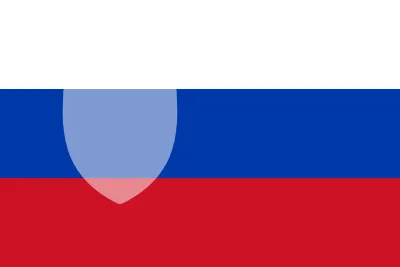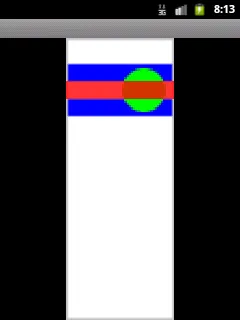这是一个显示带有附加层的图像的类:
import java.util.ArrayList;
import java.util.Iterator;
import android.content.Context;
import android.content.res.Resources;
import android.content.res.TypedArray;
import android.graphics.Bitmap;
import android.graphics.Canvas;
import android.graphics.Matrix;
import android.graphics.Rect;
import android.graphics.drawable.BitmapDrawable;
import android.graphics.drawable.Drawable;
import android.net.Uri;
import android.util.AttributeSet;
import android.util.DisplayMetrics;
import android.util.Log;
import android.util.TypedValue;
import android.view.animation.Animation;
import android.view.animation.AnimationUtils;
import android.view.animation.Transformation;
import android.widget.ImageView;
public class LayeredImageView extends ImageView {
private final static String TAG = "LayeredImageView";
private ArrayList<Layer> mLayers;
private Matrix mDrawMatrix;
private Resources mResources;
public LayeredImageView(Context context) {
super(context);
init();
}
public LayeredImageView(Context context, AttributeSet set) {
super(context, set);
init();
int[] attrs = {
android.R.attr.src
};
TypedArray a = context.obtainStyledAttributes(set, attrs);
TypedValue outValue = new TypedValue();
if (a.getValue(0, outValue)) {
setImageResource(outValue.resourceId);
}
a.recycle();
}
private void init() {
mLayers = new ArrayList<Layer>();
mDrawMatrix = new Matrix();
mResources = new LayeredImageViewResources();
}
@Override
protected boolean verifyDrawable(Drawable dr) {
for (int i = 0; i < mLayers.size(); i++) {
Layer layer = mLayers.get(i);
if (layer.drawable == dr) {
return true;
}
}
return super.verifyDrawable(dr);
}
@Override
public void invalidateDrawable(Drawable dr) {
if (verifyDrawable(dr)) {
invalidate();
} else {
super.invalidateDrawable(dr);
}
}
@Override
public Resources getResources() {
return mResources;
}
@Override
public void setImageBitmap(Bitmap bm) throws RuntimeException {
String detailMessage = "setImageBitmap not supported, use: setImageDrawable() " +
"or setImageResource()";
throw new RuntimeException(detailMessage);
}
@Override
public void setImageURI(Uri uri) throws RuntimeException {
String detailMessage = "setImageURI not supported, use: setImageDrawable() " +
"or setImageResource()";
throw new RuntimeException(detailMessage);
}
@Override
protected void onDraw(Canvas canvas) {
super.onDraw(canvas);
Matrix matrix = getImageMatrix();
if (matrix != null) {
int numLayers = mLayers.size();
boolean pendingAnimations = false;
for (int i = 0; i < numLayers; i++) {
mDrawMatrix.set(matrix);
Layer layer = mLayers.get(i);
if (layer.matrix != null) {
mDrawMatrix.preConcat(layer.matrix);
}
if (layer.animation == null) {
draw(canvas, layer.drawable, mDrawMatrix, 255);
} else {
Animation a = layer.animation;
if (!a.isInitialized()) {
Rect bounds = layer.drawable.getBounds();
Drawable parentDrawable = getDrawable();
if (parentDrawable != null) {
Rect parentBounds = parentDrawable.getBounds();
a.initialize(bounds.width(), bounds.height(), parentBounds.width(), parentBounds.height());
} else {
a.initialize(bounds.width(), bounds.height(), 0, 0);
}
}
long currentTime = AnimationUtils.currentAnimationTimeMillis();
boolean running = a.getTransformation(currentTime, layer.transformation);
if (running) {
Matrix animationFrameMatrix = layer.transformation.getMatrix();
mDrawMatrix.preConcat(animationFrameMatrix);
int alpha = (int) (255 * layer.transformation.getAlpha());
draw(canvas, layer.drawable, mDrawMatrix, alpha);
pendingAnimations = true;
} else {
layer.animation = null;
draw(canvas, layer.drawable, mDrawMatrix, 255);
}
}
}
if (pendingAnimations) {
invalidate();
}
}
}
private void draw(Canvas canvas, Drawable drawable, Matrix matrix, int alpha) {
canvas.save(Canvas.MATRIX_SAVE_FLAG);
canvas.concat(matrix);
drawable.setAlpha(alpha);
drawable.draw(canvas);
canvas.restore();
}
public Layer addLayer(Drawable d, Matrix m) {
Layer layer = new Layer(d, m);
mLayers.add(layer);
invalidate();
return layer;
}
public Layer addLayer(Drawable d) {
return addLayer(d, null);
}
public Layer addLayer(int idx, Drawable d, Matrix m) {
Layer layer = new Layer(d, m);
mLayers.add(idx, layer);
invalidate();
return layer;
}
public Layer addLayer(int idx, Drawable d) {
return addLayer(idx, d, null);
}
public void removeLayer(Layer layer) {
layer.valid = false;
mLayers.remove(layer);
}
public void removeAllLayers() {
Iterator<Layer> iter = mLayers.iterator();
while (iter.hasNext()) {
LayeredImageView.Layer layer = iter.next();
layer.valid = false;
iter.remove();
}
invalidate();
}
public int getLayersSize() {
return mLayers.size();
}
public class Layer {
private Drawable drawable;
private Animation animation;
private Transformation transformation;
private Matrix matrix;
private boolean valid;
private Layer(Drawable d, Matrix m) {
drawable = d;
transformation = new Transformation();
matrix = m;
valid = true;
Rect bounds = d.getBounds();
if (bounds.isEmpty()) {
if (d instanceof BitmapDrawable) {
int right = d.getIntrinsicWidth();
int bottom = d.getIntrinsicHeight();
d.setBounds(0, 0, right, bottom);
} else {
String detailMessage = "drawable bounds are empty, use d.setBounds()";
throw new RuntimeException(detailMessage);
}
}
d.setCallback(LayeredImageView.this);
}
public void startLayerAnimation(Animation a) throws RuntimeException {
if (!valid) {
String detailMessage = "this layer has already been removed";
throw new RuntimeException(detailMessage);
}
transformation.clear();
animation = a;
if (a != null) {
a.start();
}
invalidate();
}
public void stopLayerAnimation(int idx) throws RuntimeException {
if (!valid) {
String detailMessage = "this layer has already been removed";
throw new RuntimeException(detailMessage);
}
if (animation != null) {
animation = null;
invalidate();
}
}
}
private class LayeredImageViewResources extends Resources {
public LayeredImageViewResources() {
super(getContext().getAssets(), new DisplayMetrics(), null);
}
@Override
public Drawable getDrawable(int id) throws NotFoundException {
Drawable d = super.getDrawable(id);
if (d instanceof BitmapDrawable) {
BitmapDrawable bd = (BitmapDrawable) d;
bd.getBitmap().setDensity(DisplayMetrics.DENSITY_DEFAULT);
bd.setTargetDensity(DisplayMetrics.DENSITY_DEFAULT);
}
return d;
}
}
}
以及它的使用方式:
final LayeredImageView v = new LayeredImageView(this);
Resources res = v.getResources();
v.setImageResource(R.drawable.background);
Matrix m;
m = new Matrix();
m.preTranslate(81, 146);
final Layer layer1 = v.addLayer(res.getDrawable(R.drawable.layer1), m);
m = new Matrix();
m.preTranslate(62, 63);
final Layer layer0 = v.addLayer(0, res.getDrawable(R.drawable.layer0), m);
final AnimationDrawable ad = new AnimationDrawable();
ad.setOneShot(false);
Drawable frame1, frame2;
frame1 = res.getDrawable(R.drawable.layer0);
frame2 = res.getDrawable(R.drawable.layer1);
ad.addFrame(frame1, 3000);
ad.addFrame(frame2, 1000);
ad.addFrame(frame1, 250);
ad.addFrame(frame2, 250);
ad.addFrame(frame1, 250);
ad.addFrame(frame2, 250);
ad.addFrame(frame1, 250);
ad.addFrame(frame2, 250);
ad.setBounds(200, 20, 300, 120);
v.addLayer(1, ad);
v.post(new Runnable() {
@Override
public void run() {
ad.start();
}
});
int[] colors = {
0xeeffffff,
0xee0038a8,
0xeece1126,
};
GradientDrawable gd = new GradientDrawable(Orientation.TOP_BOTTOM, colors);
gd.setBounds(0, 0, 100, 129);
gd.setCornerRadius(20);
gd.setStroke(5, 0xaa666666);
final Matrix mm = new Matrix();
mm.preTranslate(200, 69);
mm.preRotate(20, 50, 64.5f);
final Layer layer2 = v.addLayer(2, gd, mm);
final Animation as = AnimationUtils.loadAnimation(this, R.anim.anim_set);
final Runnable action1 = new Runnable() {
@Override
public void run() {
Animation a;
Interpolator i;
i = new Interpolator() {
@Override
public float getInterpolation(float input) {
return (float) Math.sin(input * Math.PI);
}
};
as.setInterpolator(i);
layer0.startLayerAnimation(as);
a = new TranslateAnimation(0, 0, 0, 100);
a.setDuration(3000);
i = new Interpolator() {
@Override
public float getInterpolation(float input) {
float output = (float) Math.sin(Math.pow(input, 2.5f) * 12 * Math.PI);
return (1-input) * output;
}
};
a.setInterpolator(i);
layer1.startLayerAnimation(a);
a = new AlphaAnimation(0, 1);
i = new Interpolator() {
@Override
public float getInterpolation(float input) {
return (float) (1 - Math.sin(input * Math.PI));
}
};
a.setInterpolator(i);
a.setDuration(2000);
layer2.startLayerAnimation(a);
}
};
OnClickListener l1 = new OnClickListener() {
@Override
public void onClick(View view) {
action1.run();
}
};
v.setOnClickListener(l1);
v.postDelayed(action1, 2000);
setContentView(v);
anim_set.xml看起来像这样:
<?xml version="1.0" encoding="utf-8"?>
<set xmlns:android="http://schemas.android.com/apk/res/android"
android:shareInterpolator="true"
>
<rotate
android:fromDegrees="0"
android:toDegrees="30"
android:pivotX="50%"
android:pivotY="50%"
android:duration="2500"
/>
<scale
android:fromXScale="1"
android:toXScale="1.8"
android:fromYScale="1"
android:toYScale="1.8"
android:pivotX="50%"
android:pivotY="50%"
android:duration="2500"
/>
</set>
以下是图片:
background.png: 
layer0.png: 
layer1.png: 
结果为: 
重要提示:为了防止从不同的drawable-*文件夹加载时自动进行操作系统缩放,您必须使用从LayeredImageView.getResources()方法获得的Resources对象。
祝您使用愉快!








